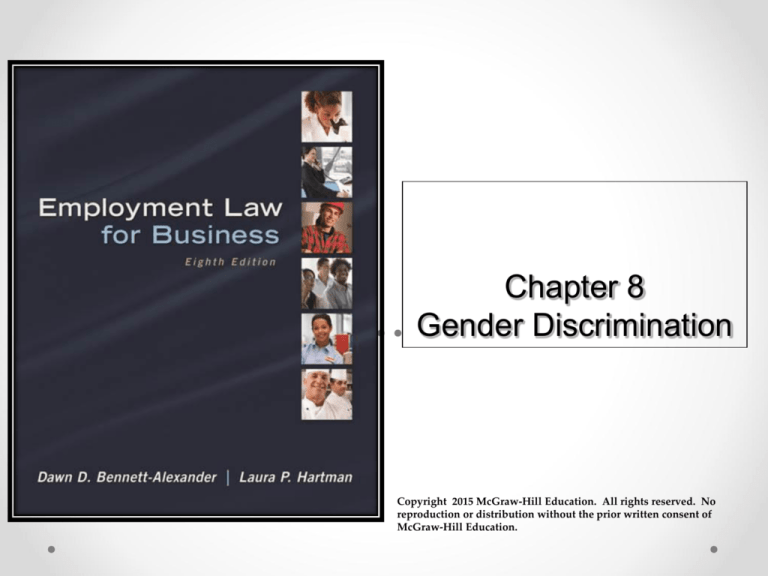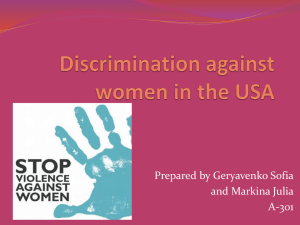
Chapter 8
Gender Discrimination
Copyright 2015 McGraw-Hill Education. All rights reserved. No
reproduction or distribution without the prior written consent of
McGraw-Hill Education.
Learning Objectives (1)
Revisit Title VII and examine other laws relating
to gender discrimination
Understand the background of gender
discrimination and how we know it still exists
Recognize the different ways in which gender
discrimination is manifested in the workplace
Differentiate between legal and illegal grooming
policies
8-2
Learning Objectives (2)
Define stereotyping, fetal protection policies,
gender-plus discrimination, workplace lactation
issues, and gender-based logistical concerns
List common gender realities at odds with
common bases for illegal workplace
determinations
Distinguish between equal pay and comparable
worth and discuss proposed legislation
8-3
Does it Really Exist? (1)
Gender discrimination covers both males and
females
The vast majority of EEOC gender claims are filed by
women
The Merrill Lynch message
“Contraceptive equity?” – analogy not perfect,
but would the rules be the same if roles were
reversed?
8-4
Does it Really Exist? (2)
In 2007 EEOC issued “family responsibility
discrimination” (FRD)
Women are more likely to suffer adverse employment
actions taken against them due to their care giving
responsibilities
http://www.eeoc.gov/policy/docs/caregiving.html
Evolving focus of EEOC claims
Shift from hiring discrimination to on-the-job issues
8-5
Does it Really Exist? (3)
Statistical evidence of gender disparity
Nearly half the workforce is female – Females
represent two-thirds of all poor adults
Only 15 percent of women work in jobs typically held
by men
A 2011 White House Commission on Women and
Girls report indicated that women earn 75 percent as
much as men at all levels of educational attainment
The gender-based wage gap is present in every
profession
8-6
Does it Really Exist? (4)
In Fortune 1000 industrial and Fortune 500
service firms, 97 percent of top managers are
white males
Gender was not originally part of the Civil Rights
Act
Amendment introduced by opponent of the Bill
Women’s Movement had not yet gained traction
Per Title VII, it is the person’s ability that must be
the basis for workplace decisions
8-7
Gender Stereotypes (1)
Women are better suited to repetitive, fine motor
skill tasks
Women are too unstable to handle jobs with a
great deal of responsibility or high pressure.
Men make better employees because they are
more aggressive
Working in an organizational hierarchy, men are
naturally more comfortable than women
8-8
Gender Stereotypes (2)
Men do not do well at jobs requiring nurturing
skills, such as day care, nursing, elder care, and
the like
When women marry they will get pregnant and
leave their jobs
When women are criticized at work, they will
become angry or vindictive
A married woman’s pay is only ‘extra’ family
income
8-9
Gender Stereotypes (3)
A woman who changes jobs is being disloyal
and unstable
A woman should not have a job that requires her
to have lunch or dinner meetings with men
Women cannot have jobs that require travel or a
good deal of time away from home
8-10
Gender Discrimination in General (1)
Advertising
Application questions
Interview questions
Different hours or job positions
Discipline
Training
8-11
Gender Discrimination in General (2)
Seniority systems (LIFO effect)
Different wages and benefits
Different terms or conditions of employment
Case: Wedow v. City of Kansas City
Termination
Familiar Disparate Treatment and Disparate
Impact claims available
8-12
Recognizing Gender Discrimination
Does a facially neutral policy exclude members
of a particular gender from the workplace or
some workplace benefit?
Case: Dothard v. Rawlinson
Do height and weight requirements statistically
exclude certain groups? (disparate impact)
Do these requirements directly correlate to ability to
do the job? (necessity)
Are there better, less discriminatory requirements?
8-13
“Gender-Plus” Discrimination
“Gender-plus” discrimination: Employment
discrimination based on gender and some other
factor such as marital status or children
Males are not subject to the same limitations
Case: Phillips v. Martin Marietta Corp.
Employer assumption re care-giving responsibility
see esp. Marshall’s ‘canards’ concurrence re BFOQ
possibility there – his view now prevails
8-14
Gender Stereotyping
Gender stereotypes: The assumption that most
or all members of a particular gender must act a
certain way
Workplace decisions based on:
Ideas of how a particular gender should act or dress
What roles they should perform
Case: Price Waterhouse v. Hopkins
Would she have qualified if she had met the stereotype?
Even supporters considered her a ‘lady partner’ candidate
8-16
Grooming Codes
Title VII does not prohibit an employer from
using gender as a basis for reasonable
grooming codes
Employer discretion: grooming codes rarely affect
opportunity
Exception: where it differentially impacts perception of
the employee in the workplace (suits v. smocks)
Seek ‘reasonable’ standards of what is generally
thought to be male- or female-appropriate attire
in a business setting, monitor for impact
8-17
Customer or Employee Preferences
Customer preference is not a legitimate and
protected reason to treat otherwise-qualified
employees differently based on gender
The ‘Hooters’ situation …
Civil Rights Act of 1991
Title VII generally applies to U.S. citizens employed
by American-owned or -controlled companies doing
business outside the United States (legal exception)
8-18
Logistical Considerations
Breast-feeding/expressing milk at work
Employers may not forgo hiring those of a
certain gender because of logistical issues,
unless it involves an unreasonable financial
burden (rare)
Examples:
Female sports reporters
Female firefighters
Bathroom facilities Case: Lynch v. Freeman
8-19
Equal Pay and Comparable Worth (1)
Despite the Equal Pay Act, women earn on
average 77 cents for every dollar earned by
men.
Women’s salaries may be equal by the year 2050
The EPAct overlaps with Title VII’s general
prohibition against discrimination in employment
on the basis of gender.
EPAct concerns the practical content of the job, not
title or description
8-20
Equal Pay and Comparable Worth (2)
Title VII’s Bennett Amendment
Exceptions permitted by EPAct (re seniority, output
pay) recognized under Title VII
Comparable worth: A Title VII action for pay
discrimination based on gender
Jobs held mostly by women are compared with
comparable jobs held mostly by men
Pay compared, to determine if there is gender
discrimination
8-21
Gender as a BFOQ
Title VII permits gender to be used as a bona fide
occupational qualification under certain limited
circumstances (“privacy” has been an interesting issue)
The EEOC guidelines for gender as a BFOQ are very
strict (sperm donor, wet nurse)
BFOQ as a defense generally found inapplicable
Informal EEOC guidance:
http://www.eeoc.gov/eeoc/foia/letters/2002/titlevii_bfo
q.html
A few cases have allowed BFOQs, usually privacybased
8-22
Pregnancy Discrimination
The Pregnancy Discrimination Act
Prohibits discrimination based on pregnancy,
childbirth, or related medical conditions
Followed Supreme Court’s conclusion that pregnancy was
not meant to be covered by Title VII
Amended Title VII to expressly include pregnancy
EEOC report
182 percent increase in the filing of pregnancy
discrimination charges over the past 10 years
8-23
Fetal Protection Policies
Fetal protection policies: Policies an employer
institutes to protect the fetus or the reproductive
capacity of employees
Limit or prohibit employees from performing
certain jobs or working in certain areas
Many times these policies only exclude females
E.g., UAW v. Johnson Controls
8-24
Management Tips (1)
Send the message that gender bias will not be
tolerated
Back up message with appropriate enforcement
Take employee claims seriously
Promptly and thoroughly investigate all
complaints
Make sure the “punishment fits the crime.”
8-25
Management Tips (2)
Conduct periodic training to remind employees
about the anti-bias policy
Conduct periodic audits, reviews of workplace
policies
Actions taken to address gender issues need not
make the workplace stilted or formal
8-26







